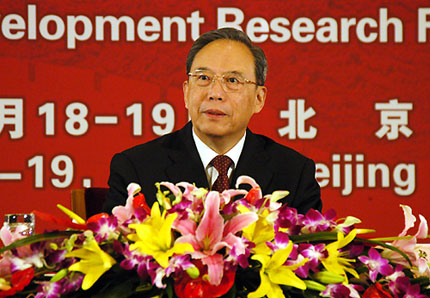Pattern of growth 'has to change'
By Zhu Qiwen (China Daily)Updated: 2007-03-19 06:48
 Vice Premier Zeng Peiyan speaks at the China Development Forum in Beijing March 18, 2007. [Xinhua]  |
They said that if the current growth pattern based on high consumption of energy and resources is not changed, the Chinese economy may begin to stutter.
"Serious environmental and resources constraints, irrational industrial structure, and development gaps between urban and rural areas as well as between regions make it imperative to accelerate change of the growth model in pursuit of sustainable development," said Vice-Premier Zeng Peiyan at the opening session of China Development Forum.
The two-day forum is organized by the China Development Research Foundation for high-level discussions among policy-makers, researchers and business leaders on China's transition toward a new development model.
The vice-premier promised more reforms of pricing mechanisms and tax incentives as well as increased efforts to encourage energy saving and environmental protection.
Ma Kai, minister of the National Development and Reform Commission, said: "The overall growth of the Chinese economy is inspiring, but one of the worries is that we have paid too dear an environmental and resources price for such growth."
The economy grew by 10.7 percent last year while profits soared and inflation stayed low. But low efficiency in use of energy and resources is still a problem, Ma pointed out.
The country's GDP reached $2.16 trillion last year, about 5.5 percent of the world's total GDP. At the same time, the country accounted for about 15 percent of the world's energy consumption, using 30 percent of steel and 54 percent of cement.
The reasons for low energy efficiency include accelerated industrialization and urbanization, energy-and-resource-intensive production during the course of economic globalization, and the extensive growth pattern of the national economy, according to Ma.
"We are keenly aware that if the country's growth pattern is not changed as soon as possible, though the Chinese economy can maintain rapid growth for a period, it will not sail well and sail far," warned Ma.
Participants at the forum also emphasized the need for China to focus more on boosting domestic demand.
China's rapid economic growth has so far largely been fuelled by sizzling export and investment growth.
Stephan Roach, chief economist of Morgan Stanley, said a successful re-balancing of the economy is needed if the nation is to reduce pollution generated by high-energy consuming industries.
|
||
|
||
|
|